Children's Creative Learning: Standards, Activities, and Evaluation
VerifiedAdded on 2020/01/15
|12
|3367
|214
Report
AI Summary
This report delves into the multifaceted aspects of children's creative learning, providing a comprehensive overview of standards, frameworks, and practical activities designed to nurture young minds. It explores the importance of a safe and stimulating environment, detailing how to incorporate natural and found materials into art projects. The report outlines various techniques to enhance creativity, including role-modeling, open-ended questioning, and problem-solving scenarios. It also includes case studies, methods for evaluating child learning, and strategies for creating a creative learning environment. Furthermore, the report provides insights into encouraging children to respect and appreciate each other's work, fostering a positive and collaborative learning atmosphere. The document emphasizes the significance of adapting creative approaches and using diverse techniques to educate children, ultimately aiming to inspire and support their creative development.
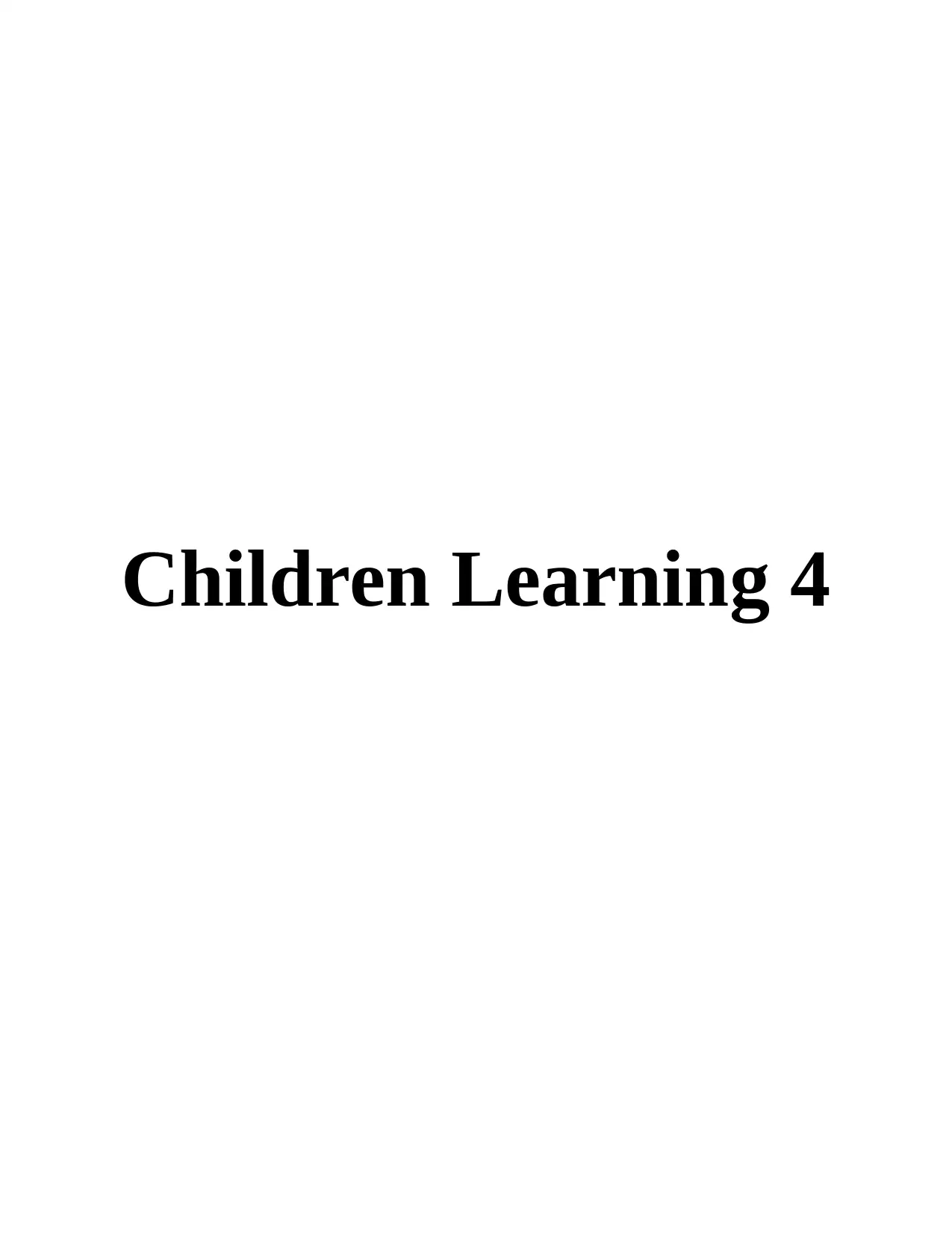
Children Learning 4
Paraphrase This Document
Need a fresh take? Get an instant paraphrase of this document with our AI Paraphraser
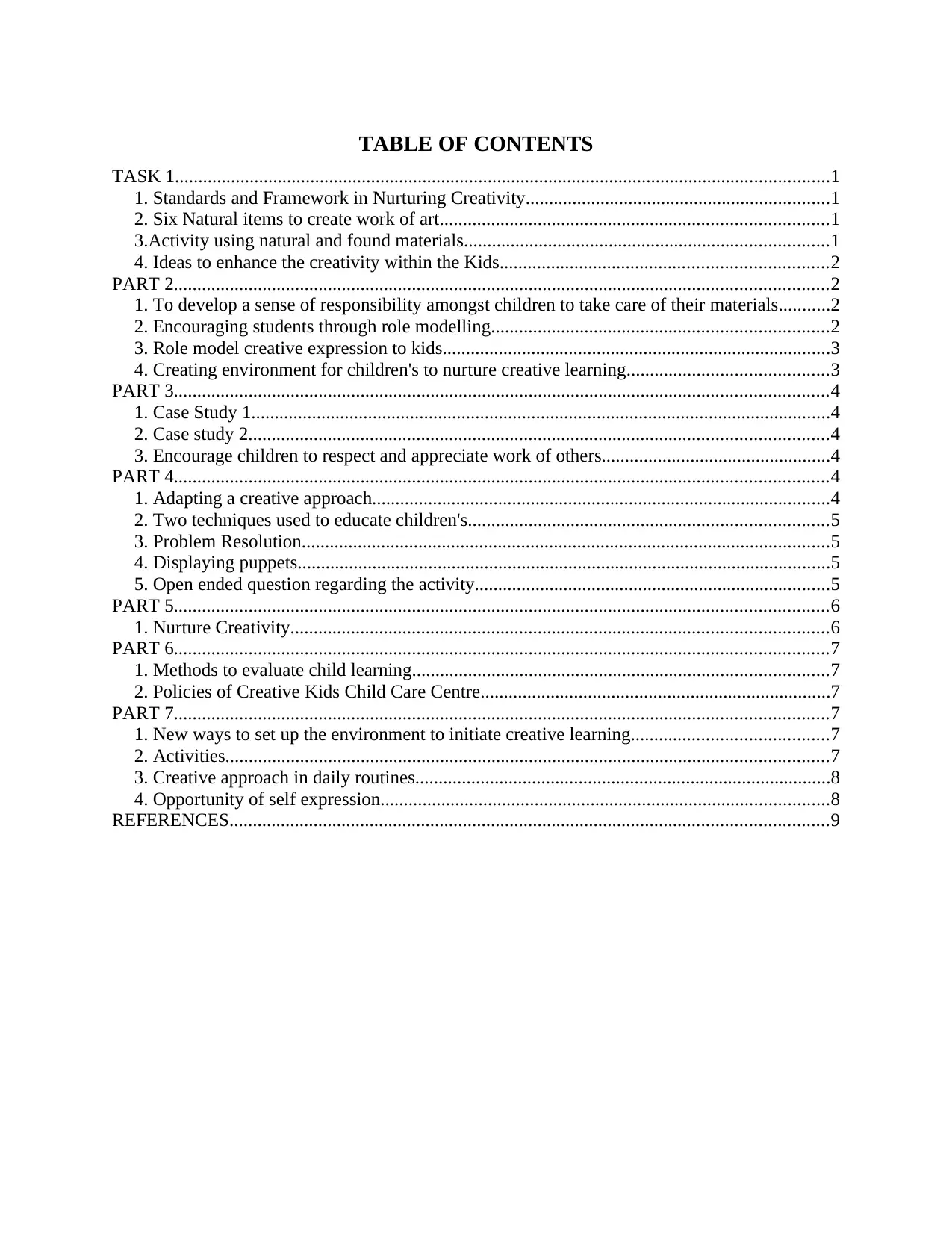
TABLE OF CONTENTS
TASK 1............................................................................................................................................1
1. Standards and Framework in Nurturing Creativity.................................................................1
2. Six Natural items to create work of art...................................................................................1
3.Activity using natural and found materials..............................................................................1
4. Ideas to enhance the creativity within the Kids......................................................................2
PART 2............................................................................................................................................2
1. To develop a sense of responsibility amongst children to take care of their materials...........2
2. Encouraging students through role modelling........................................................................2
3. Role model creative expression to kids...................................................................................3
4. Creating environment for children's to nurture creative learning...........................................3
PART 3............................................................................................................................................4
1. Case Study 1............................................................................................................................4
2. Case study 2............................................................................................................................4
3. Encourage children to respect and appreciate work of others.................................................4
PART 4............................................................................................................................................4
1. Adapting a creative approach..................................................................................................4
2. Two techniques used to educate children's.............................................................................5
3. Problem Resolution.................................................................................................................5
4. Displaying puppets..................................................................................................................5
5. Open ended question regarding the activity............................................................................5
PART 5............................................................................................................................................6
1. Nurture Creativity...................................................................................................................6
PART 6............................................................................................................................................7
1. Methods to evaluate child learning.........................................................................................7
2. Policies of Creative Kids Child Care Centre...........................................................................7
PART 7............................................................................................................................................7
1. New ways to set up the environment to initiate creative learning..........................................7
2. Activities.................................................................................................................................7
3. Creative approach in daily routines.........................................................................................8
4. Opportunity of self expression................................................................................................8
REFERENCES................................................................................................................................9
TASK 1............................................................................................................................................1
1. Standards and Framework in Nurturing Creativity.................................................................1
2. Six Natural items to create work of art...................................................................................1
3.Activity using natural and found materials..............................................................................1
4. Ideas to enhance the creativity within the Kids......................................................................2
PART 2............................................................................................................................................2
1. To develop a sense of responsibility amongst children to take care of their materials...........2
2. Encouraging students through role modelling........................................................................2
3. Role model creative expression to kids...................................................................................3
4. Creating environment for children's to nurture creative learning...........................................3
PART 3............................................................................................................................................4
1. Case Study 1............................................................................................................................4
2. Case study 2............................................................................................................................4
3. Encourage children to respect and appreciate work of others.................................................4
PART 4............................................................................................................................................4
1. Adapting a creative approach..................................................................................................4
2. Two techniques used to educate children's.............................................................................5
3. Problem Resolution.................................................................................................................5
4. Displaying puppets..................................................................................................................5
5. Open ended question regarding the activity............................................................................5
PART 5............................................................................................................................................6
1. Nurture Creativity...................................................................................................................6
PART 6............................................................................................................................................7
1. Methods to evaluate child learning.........................................................................................7
2. Policies of Creative Kids Child Care Centre...........................................................................7
PART 7............................................................................................................................................7
1. New ways to set up the environment to initiate creative learning..........................................7
2. Activities.................................................................................................................................7
3. Creative approach in daily routines.........................................................................................8
4. Opportunity of self expression................................................................................................8
REFERENCES................................................................................................................................9
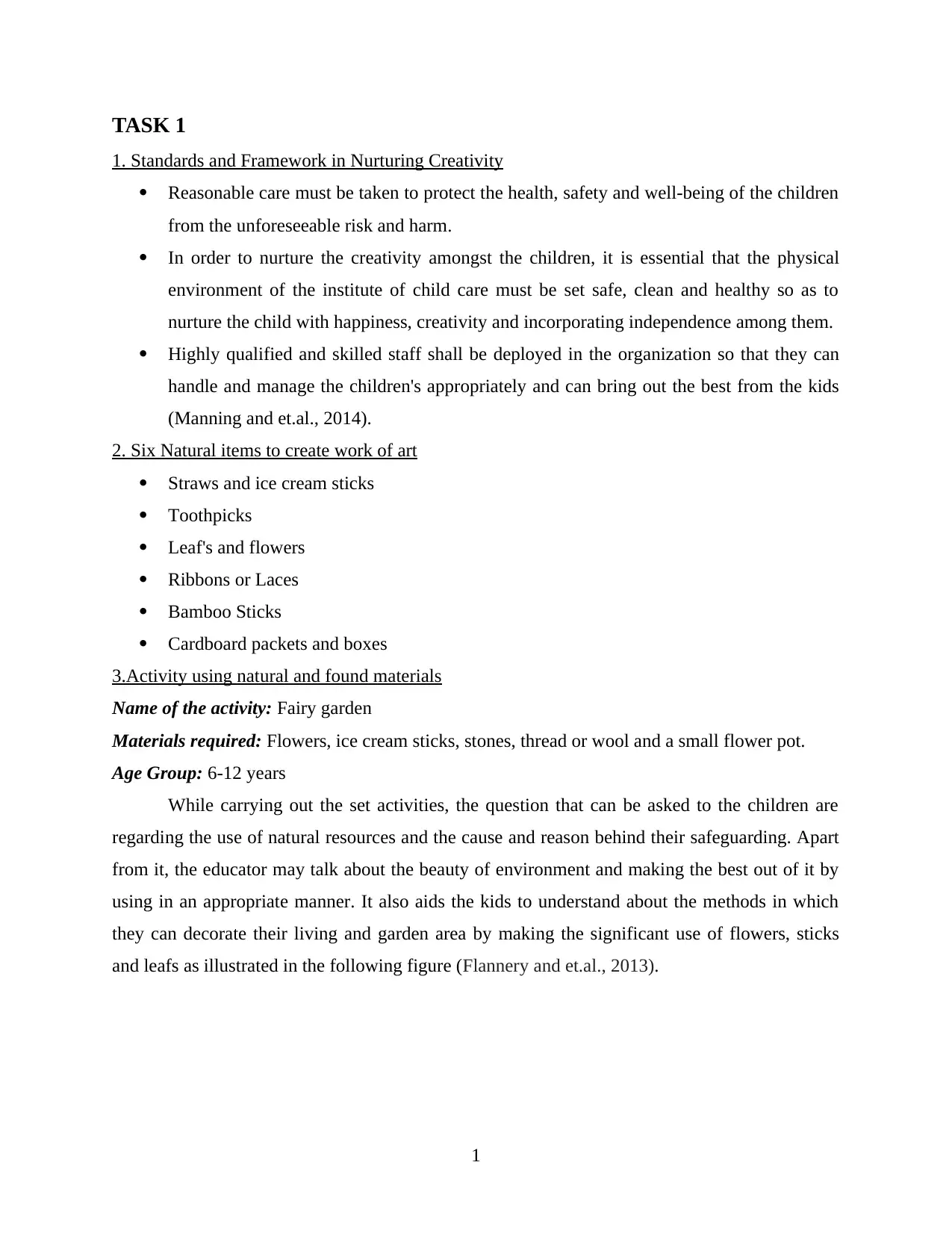
TASK 1
1. Standards and Framework in Nurturing Creativity
Reasonable care must be taken to protect the health, safety and well-being of the children
from the unforeseeable risk and harm.
In order to nurture the creativity amongst the children, it is essential that the physical
environment of the institute of child care must be set safe, clean and healthy so as to
nurture the child with happiness, creativity and incorporating independence among them.
Highly qualified and skilled staff shall be deployed in the organization so that they can
handle and manage the children's appropriately and can bring out the best from the kids
(Manning and et.al., 2014).
2. Six Natural items to create work of art
Straws and ice cream sticks
Toothpicks
Leaf's and flowers
Ribbons or Laces
Bamboo Sticks
Cardboard packets and boxes
3.Activity using natural and found materials
Name of the activity: Fairy garden
Materials required: Flowers, ice cream sticks, stones, thread or wool and a small flower pot.
Age Group: 6-12 years
While carrying out the set activities, the question that can be asked to the children are
regarding the use of natural resources and the cause and reason behind their safeguarding. Apart
from it, the educator may talk about the beauty of environment and making the best out of it by
using in an appropriate manner. It also aids the kids to understand about the methods in which
they can decorate their living and garden area by making the significant use of flowers, sticks
and leafs as illustrated in the following figure (Flannery and et.al., 2013).
1
1. Standards and Framework in Nurturing Creativity
Reasonable care must be taken to protect the health, safety and well-being of the children
from the unforeseeable risk and harm.
In order to nurture the creativity amongst the children, it is essential that the physical
environment of the institute of child care must be set safe, clean and healthy so as to
nurture the child with happiness, creativity and incorporating independence among them.
Highly qualified and skilled staff shall be deployed in the organization so that they can
handle and manage the children's appropriately and can bring out the best from the kids
(Manning and et.al., 2014).
2. Six Natural items to create work of art
Straws and ice cream sticks
Toothpicks
Leaf's and flowers
Ribbons or Laces
Bamboo Sticks
Cardboard packets and boxes
3.Activity using natural and found materials
Name of the activity: Fairy garden
Materials required: Flowers, ice cream sticks, stones, thread or wool and a small flower pot.
Age Group: 6-12 years
While carrying out the set activities, the question that can be asked to the children are
regarding the use of natural resources and the cause and reason behind their safeguarding. Apart
from it, the educator may talk about the beauty of environment and making the best out of it by
using in an appropriate manner. It also aids the kids to understand about the methods in which
they can decorate their living and garden area by making the significant use of flowers, sticks
and leafs as illustrated in the following figure (Flannery and et.al., 2013).
1
⊘ This is a preview!⊘
Do you want full access?
Subscribe today to unlock all pages.

Trusted by 1+ million students worldwide
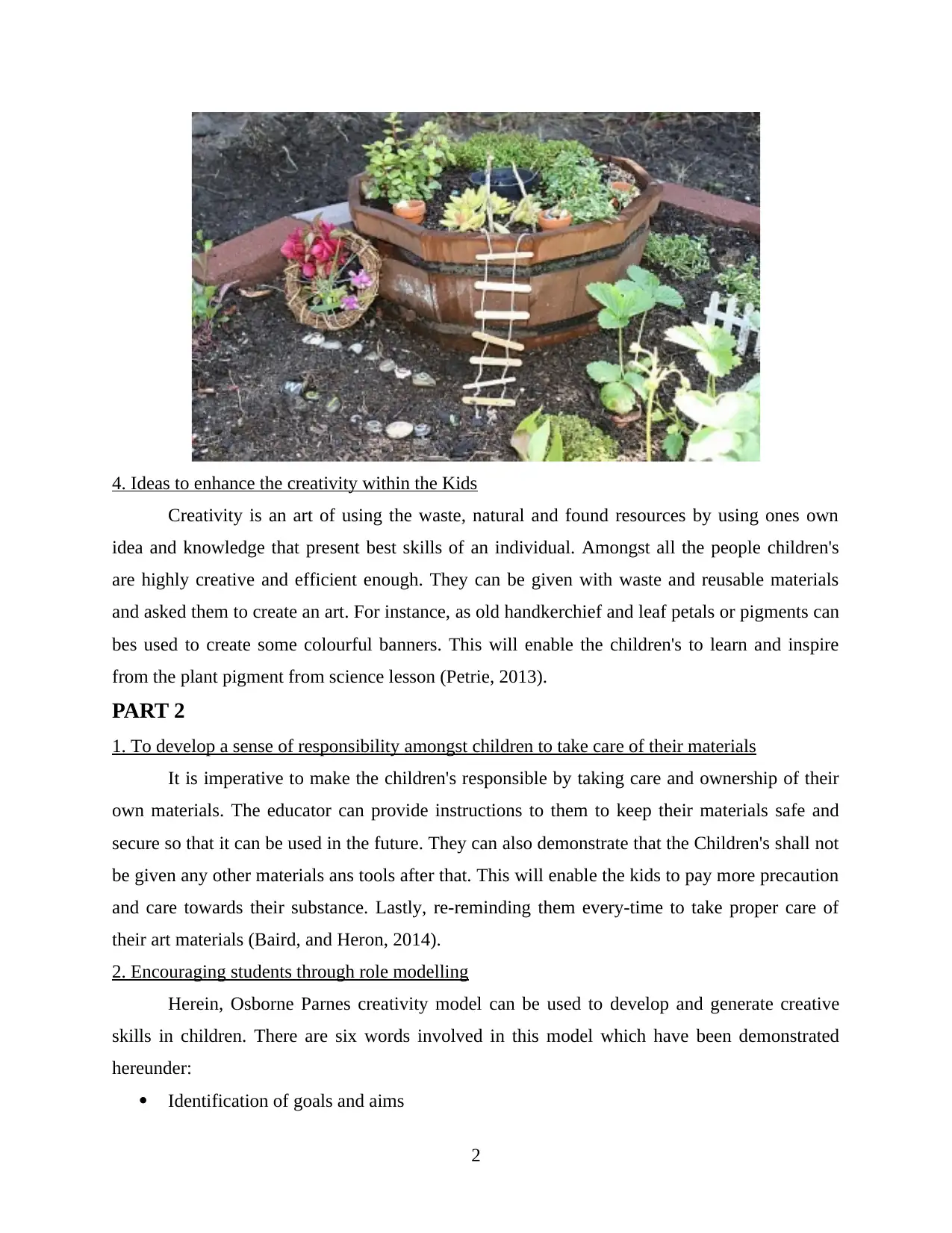
4. Ideas to enhance the creativity within the Kids
Creativity is an art of using the waste, natural and found resources by using ones own
idea and knowledge that present best skills of an individual. Amongst all the people children's
are highly creative and efficient enough. They can be given with waste and reusable materials
and asked them to create an art. For instance, as old handkerchief and leaf petals or pigments can
bes used to create some colourful banners. This will enable the children's to learn and inspire
from the plant pigment from science lesson (Petrie, 2013).
PART 2
1. To develop a sense of responsibility amongst children to take care of their materials
It is imperative to make the children's responsible by taking care and ownership of their
own materials. The educator can provide instructions to them to keep their materials safe and
secure so that it can be used in the future. They can also demonstrate that the Children's shall not
be given any other materials ans tools after that. This will enable the kids to pay more precaution
and care towards their substance. Lastly, re-reminding them every-time to take proper care of
their art materials (Baird, and Heron, 2014).
2. Encouraging students through role modelling
Herein, Osborne Parnes creativity model can be used to develop and generate creative
skills in children. There are six words involved in this model which have been demonstrated
hereunder:
Identification of goals and aims
2
Creativity is an art of using the waste, natural and found resources by using ones own
idea and knowledge that present best skills of an individual. Amongst all the people children's
are highly creative and efficient enough. They can be given with waste and reusable materials
and asked them to create an art. For instance, as old handkerchief and leaf petals or pigments can
bes used to create some colourful banners. This will enable the children's to learn and inspire
from the plant pigment from science lesson (Petrie, 2013).
PART 2
1. To develop a sense of responsibility amongst children to take care of their materials
It is imperative to make the children's responsible by taking care and ownership of their
own materials. The educator can provide instructions to them to keep their materials safe and
secure so that it can be used in the future. They can also demonstrate that the Children's shall not
be given any other materials ans tools after that. This will enable the kids to pay more precaution
and care towards their substance. Lastly, re-reminding them every-time to take proper care of
their art materials (Baird, and Heron, 2014).
2. Encouraging students through role modelling
Herein, Osborne Parnes creativity model can be used to develop and generate creative
skills in children. There are six words involved in this model which have been demonstrated
hereunder:
Identification of goals and aims
2
Paraphrase This Document
Need a fresh take? Get an instant paraphrase of this document with our AI Paraphraser
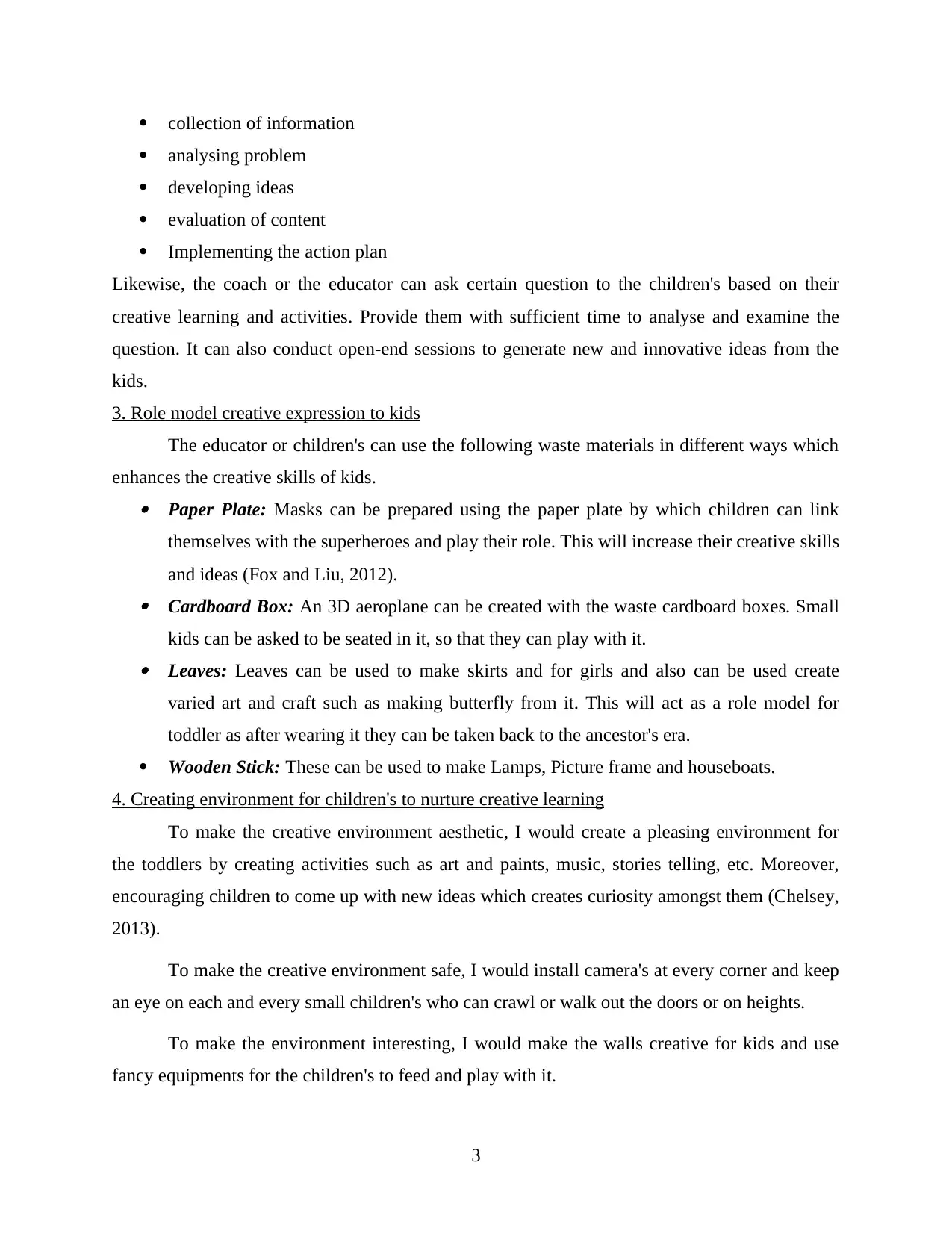
collection of information
analysing problem
developing ideas
evaluation of content
Implementing the action plan
Likewise, the coach or the educator can ask certain question to the children's based on their
creative learning and activities. Provide them with sufficient time to analyse and examine the
question. It can also conduct open-end sessions to generate new and innovative ideas from the
kids.
3. Role model creative expression to kids
The educator or children's can use the following waste materials in different ways which
enhances the creative skills of kids. Paper Plate: Masks can be prepared using the paper plate by which children can link
themselves with the superheroes and play their role. This will increase their creative skills
and ideas (Fox and Liu, 2012). Cardboard Box: An 3D aeroplane can be created with the waste cardboard boxes. Small
kids can be asked to be seated in it, so that they can play with it. Leaves: Leaves can be used to make skirts and for girls and also can be used create
varied art and craft such as making butterfly from it. This will act as a role model for
toddler as after wearing it they can be taken back to the ancestor's era.
Wooden Stick: These can be used to make Lamps, Picture frame and houseboats.
4. Creating environment for children's to nurture creative learning
To make the creative environment aesthetic, I would create a pleasing environment for
the toddlers by creating activities such as art and paints, music, stories telling, etc. Moreover,
encouraging children to come up with new ideas which creates curiosity amongst them (Chelsey,
2013).
To make the creative environment safe, I would install camera's at every corner and keep
an eye on each and every small children's who can crawl or walk out the doors or on heights.
To make the environment interesting, I would make the walls creative for kids and use
fancy equipments for the children's to feed and play with it.
3
analysing problem
developing ideas
evaluation of content
Implementing the action plan
Likewise, the coach or the educator can ask certain question to the children's based on their
creative learning and activities. Provide them with sufficient time to analyse and examine the
question. It can also conduct open-end sessions to generate new and innovative ideas from the
kids.
3. Role model creative expression to kids
The educator or children's can use the following waste materials in different ways which
enhances the creative skills of kids. Paper Plate: Masks can be prepared using the paper plate by which children can link
themselves with the superheroes and play their role. This will increase their creative skills
and ideas (Fox and Liu, 2012). Cardboard Box: An 3D aeroplane can be created with the waste cardboard boxes. Small
kids can be asked to be seated in it, so that they can play with it. Leaves: Leaves can be used to make skirts and for girls and also can be used create
varied art and craft such as making butterfly from it. This will act as a role model for
toddler as after wearing it they can be taken back to the ancestor's era.
Wooden Stick: These can be used to make Lamps, Picture frame and houseboats.
4. Creating environment for children's to nurture creative learning
To make the creative environment aesthetic, I would create a pleasing environment for
the toddlers by creating activities such as art and paints, music, stories telling, etc. Moreover,
encouraging children to come up with new ideas which creates curiosity amongst them (Chelsey,
2013).
To make the creative environment safe, I would install camera's at every corner and keep
an eye on each and every small children's who can crawl or walk out the doors or on heights.
To make the environment interesting, I would make the walls creative for kids and use
fancy equipments for the children's to feed and play with it.
3
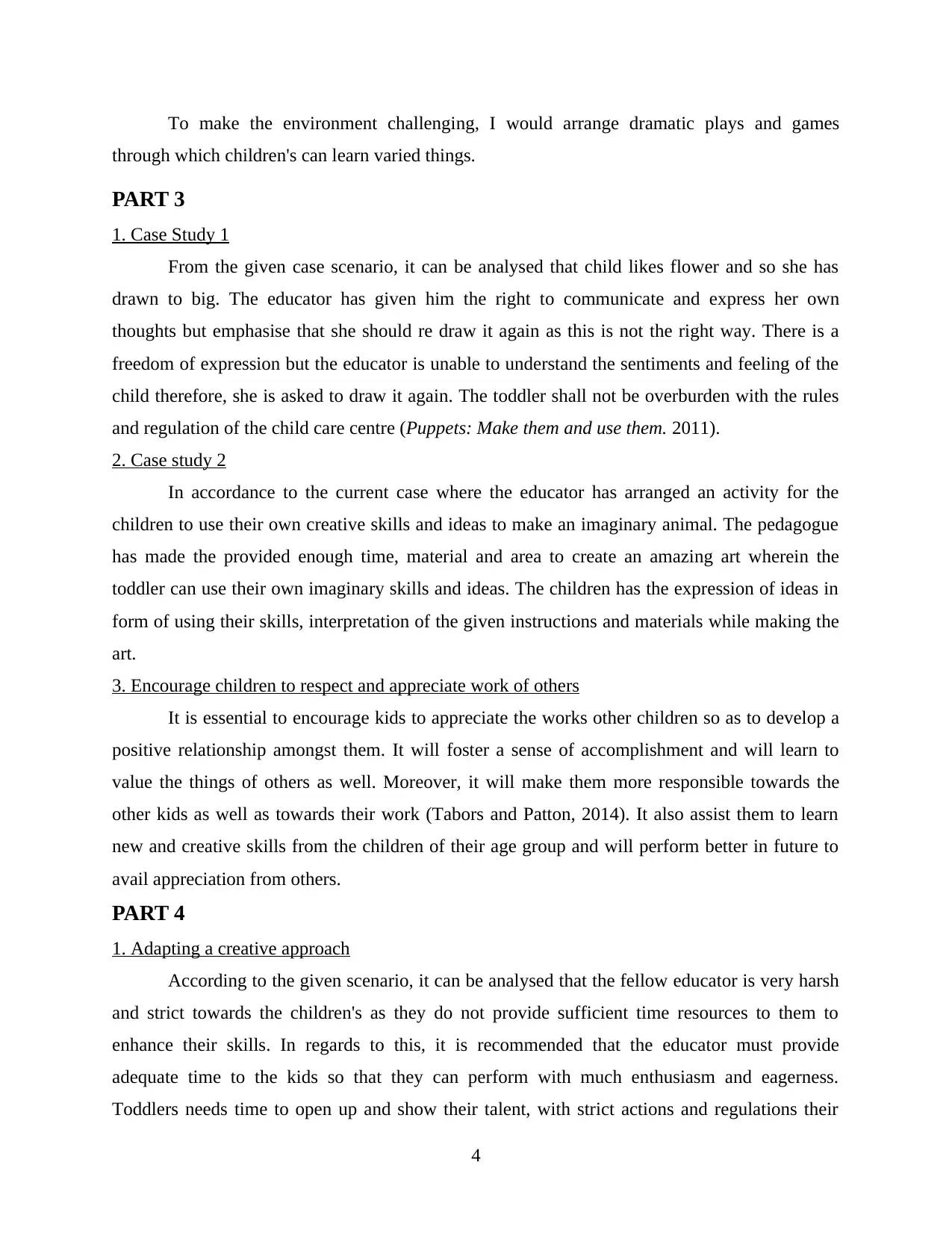
To make the environment challenging, I would arrange dramatic plays and games
through which children's can learn varied things.
PART 3
1. Case Study 1
From the given case scenario, it can be analysed that child likes flower and so she has
drawn to big. The educator has given him the right to communicate and express her own
thoughts but emphasise that she should re draw it again as this is not the right way. There is a
freedom of expression but the educator is unable to understand the sentiments and feeling of the
child therefore, she is asked to draw it again. The toddler shall not be overburden with the rules
and regulation of the child care centre (Puppets: Make them and use them. 2011).
2. Case study 2
In accordance to the current case where the educator has arranged an activity for the
children to use their own creative skills and ideas to make an imaginary animal. The pedagogue
has made the provided enough time, material and area to create an amazing art wherein the
toddler can use their own imaginary skills and ideas. The children has the expression of ideas in
form of using their skills, interpretation of the given instructions and materials while making the
art.
3. Encourage children to respect and appreciate work of others
It is essential to encourage kids to appreciate the works other children so as to develop a
positive relationship amongst them. It will foster a sense of accomplishment and will learn to
value the things of others as well. Moreover, it will make them more responsible towards the
other kids as well as towards their work (Tabors and Patton, 2014). It also assist them to learn
new and creative skills from the children of their age group and will perform better in future to
avail appreciation from others.
PART 4
1. Adapting a creative approach
According to the given scenario, it can be analysed that the fellow educator is very harsh
and strict towards the children's as they do not provide sufficient time resources to them to
enhance their skills. In regards to this, it is recommended that the educator must provide
adequate time to the kids so that they can perform with much enthusiasm and eagerness.
Toddlers needs time to open up and show their talent, with strict actions and regulations their
4
through which children's can learn varied things.
PART 3
1. Case Study 1
From the given case scenario, it can be analysed that child likes flower and so she has
drawn to big. The educator has given him the right to communicate and express her own
thoughts but emphasise that she should re draw it again as this is not the right way. There is a
freedom of expression but the educator is unable to understand the sentiments and feeling of the
child therefore, she is asked to draw it again. The toddler shall not be overburden with the rules
and regulation of the child care centre (Puppets: Make them and use them. 2011).
2. Case study 2
In accordance to the current case where the educator has arranged an activity for the
children to use their own creative skills and ideas to make an imaginary animal. The pedagogue
has made the provided enough time, material and area to create an amazing art wherein the
toddler can use their own imaginary skills and ideas. The children has the expression of ideas in
form of using their skills, interpretation of the given instructions and materials while making the
art.
3. Encourage children to respect and appreciate work of others
It is essential to encourage kids to appreciate the works other children so as to develop a
positive relationship amongst them. It will foster a sense of accomplishment and will learn to
value the things of others as well. Moreover, it will make them more responsible towards the
other kids as well as towards their work (Tabors and Patton, 2014). It also assist them to learn
new and creative skills from the children of their age group and will perform better in future to
avail appreciation from others.
PART 4
1. Adapting a creative approach
According to the given scenario, it can be analysed that the fellow educator is very harsh
and strict towards the children's as they do not provide sufficient time resources to them to
enhance their skills. In regards to this, it is recommended that the educator must provide
adequate time to the kids so that they can perform with much enthusiasm and eagerness.
Toddlers needs time to open up and show their talent, with strict actions and regulations their
4
⊘ This is a preview!⊘
Do you want full access?
Subscribe today to unlock all pages.

Trusted by 1+ million students worldwide
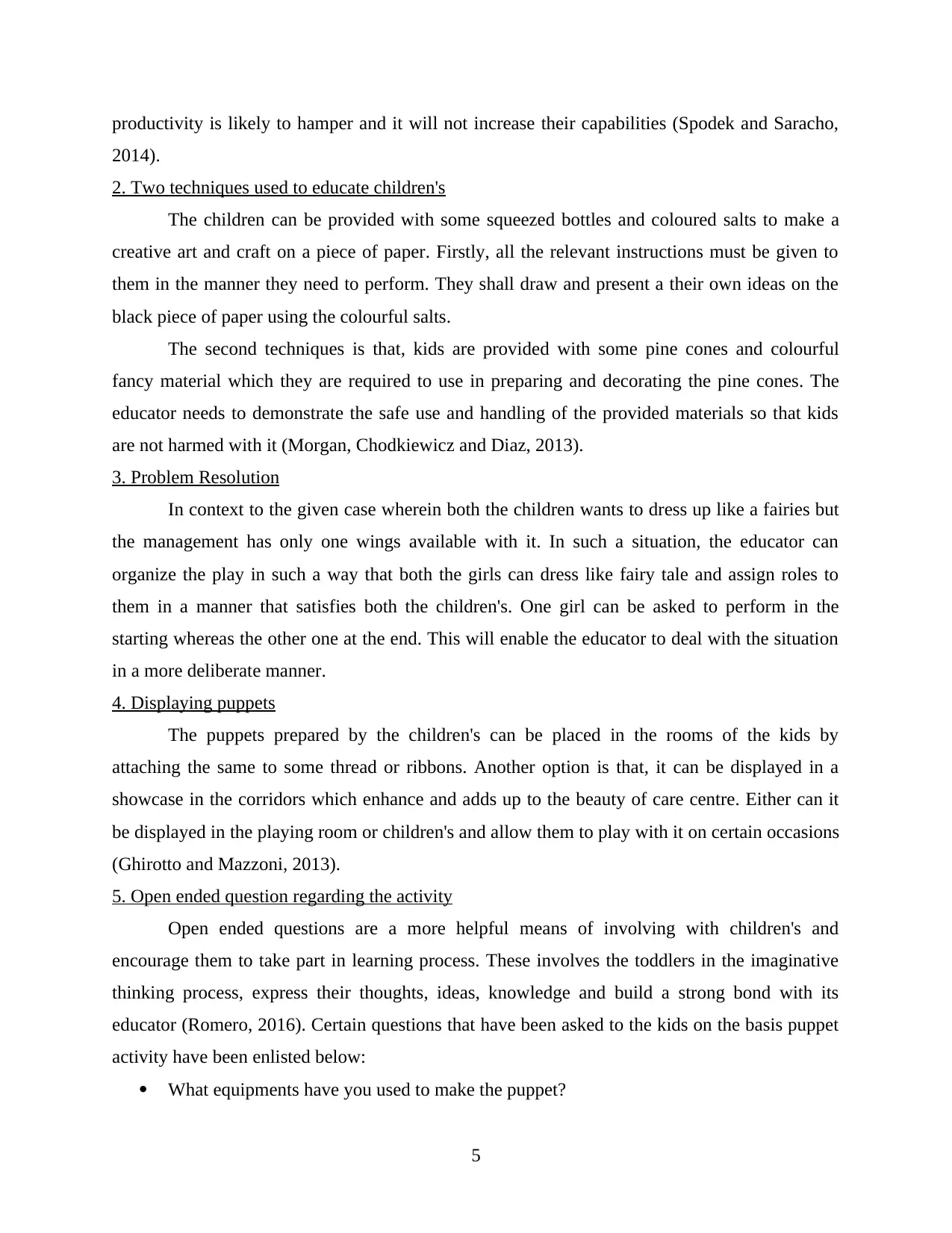
productivity is likely to hamper and it will not increase their capabilities (Spodek and Saracho,
2014).
2. Two techniques used to educate children's
The children can be provided with some squeezed bottles and coloured salts to make a
creative art and craft on a piece of paper. Firstly, all the relevant instructions must be given to
them in the manner they need to perform. They shall draw and present a their own ideas on the
black piece of paper using the colourful salts.
The second techniques is that, kids are provided with some pine cones and colourful
fancy material which they are required to use in preparing and decorating the pine cones. The
educator needs to demonstrate the safe use and handling of the provided materials so that kids
are not harmed with it (Morgan, Chodkiewicz and Diaz, 2013).
3. Problem Resolution
In context to the given case wherein both the children wants to dress up like a fairies but
the management has only one wings available with it. In such a situation, the educator can
organize the play in such a way that both the girls can dress like fairy tale and assign roles to
them in a manner that satisfies both the children's. One girl can be asked to perform in the
starting whereas the other one at the end. This will enable the educator to deal with the situation
in a more deliberate manner.
4. Displaying puppets
The puppets prepared by the children's can be placed in the rooms of the kids by
attaching the same to some thread or ribbons. Another option is that, it can be displayed in a
showcase in the corridors which enhance and adds up to the beauty of care centre. Either can it
be displayed in the playing room or children's and allow them to play with it on certain occasions
(Ghirotto and Mazzoni, 2013).
5. Open ended question regarding the activity
Open ended questions are a more helpful means of involving with children's and
encourage them to take part in learning process. These involves the toddlers in the imaginative
thinking process, express their thoughts, ideas, knowledge and build a strong bond with its
educator (Romero, 2016). Certain questions that have been asked to the kids on the basis puppet
activity have been enlisted below:
What equipments have you used to make the puppet?
5
2014).
2. Two techniques used to educate children's
The children can be provided with some squeezed bottles and coloured salts to make a
creative art and craft on a piece of paper. Firstly, all the relevant instructions must be given to
them in the manner they need to perform. They shall draw and present a their own ideas on the
black piece of paper using the colourful salts.
The second techniques is that, kids are provided with some pine cones and colourful
fancy material which they are required to use in preparing and decorating the pine cones. The
educator needs to demonstrate the safe use and handling of the provided materials so that kids
are not harmed with it (Morgan, Chodkiewicz and Diaz, 2013).
3. Problem Resolution
In context to the given case wherein both the children wants to dress up like a fairies but
the management has only one wings available with it. In such a situation, the educator can
organize the play in such a way that both the girls can dress like fairy tale and assign roles to
them in a manner that satisfies both the children's. One girl can be asked to perform in the
starting whereas the other one at the end. This will enable the educator to deal with the situation
in a more deliberate manner.
4. Displaying puppets
The puppets prepared by the children's can be placed in the rooms of the kids by
attaching the same to some thread or ribbons. Another option is that, it can be displayed in a
showcase in the corridors which enhance and adds up to the beauty of care centre. Either can it
be displayed in the playing room or children's and allow them to play with it on certain occasions
(Ghirotto and Mazzoni, 2013).
5. Open ended question regarding the activity
Open ended questions are a more helpful means of involving with children's and
encourage them to take part in learning process. These involves the toddlers in the imaginative
thinking process, express their thoughts, ideas, knowledge and build a strong bond with its
educator (Romero, 2016). Certain questions that have been asked to the kids on the basis puppet
activity have been enlisted below:
What equipments have you used to make the puppet?
5
Paraphrase This Document
Need a fresh take? Get an instant paraphrase of this document with our AI Paraphraser
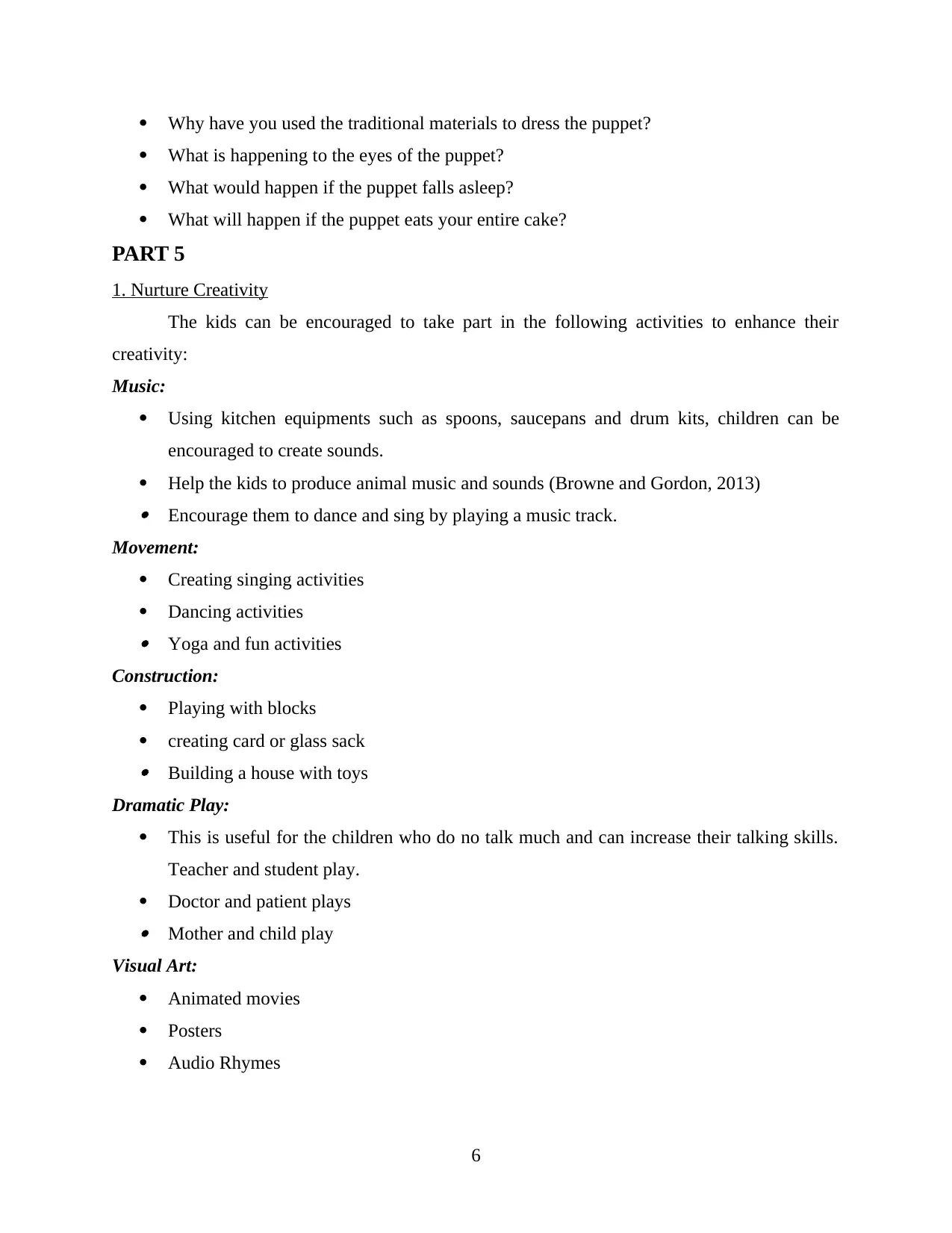
Why have you used the traditional materials to dress the puppet?
What is happening to the eyes of the puppet?
What would happen if the puppet falls asleep?
What will happen if the puppet eats your entire cake?
PART 5
1. Nurture Creativity
The kids can be encouraged to take part in the following activities to enhance their
creativity:
Music:
Using kitchen equipments such as spoons, saucepans and drum kits, children can be
encouraged to create sounds.
Help the kids to produce animal music and sounds (Browne and Gordon, 2013) Encourage them to dance and sing by playing a music track.
Movement:
Creating singing activities
Dancing activities Yoga and fun activities
Construction:
Playing with blocks
creating card or glass sack Building a house with toys
Dramatic Play:
This is useful for the children who do no talk much and can increase their talking skills.
Teacher and student play.
Doctor and patient plays Mother and child play
Visual Art:
Animated movies
Posters
Audio Rhymes
6
What is happening to the eyes of the puppet?
What would happen if the puppet falls asleep?
What will happen if the puppet eats your entire cake?
PART 5
1. Nurture Creativity
The kids can be encouraged to take part in the following activities to enhance their
creativity:
Music:
Using kitchen equipments such as spoons, saucepans and drum kits, children can be
encouraged to create sounds.
Help the kids to produce animal music and sounds (Browne and Gordon, 2013) Encourage them to dance and sing by playing a music track.
Movement:
Creating singing activities
Dancing activities Yoga and fun activities
Construction:
Playing with blocks
creating card or glass sack Building a house with toys
Dramatic Play:
This is useful for the children who do no talk much and can increase their talking skills.
Teacher and student play.
Doctor and patient plays Mother and child play
Visual Art:
Animated movies
Posters
Audio Rhymes
6
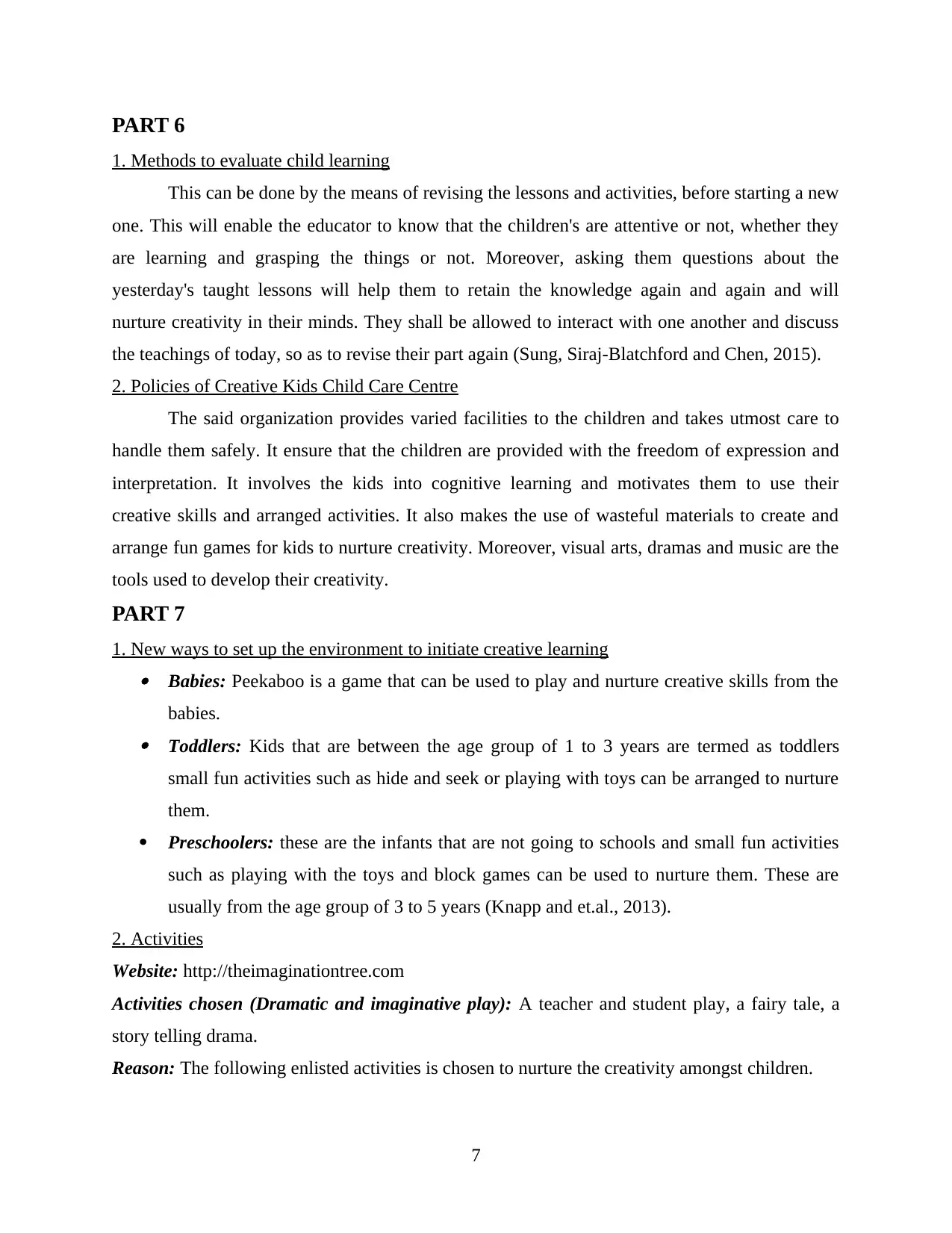
PART 6
1. Methods to evaluate child learning
This can be done by the means of revising the lessons and activities, before starting a new
one. This will enable the educator to know that the children's are attentive or not, whether they
are learning and grasping the things or not. Moreover, asking them questions about the
yesterday's taught lessons will help them to retain the knowledge again and again and will
nurture creativity in their minds. They shall be allowed to interact with one another and discuss
the teachings of today, so as to revise their part again (Sung, Siraj-Blatchford and Chen, 2015).
2. Policies of Creative Kids Child Care Centre
The said organization provides varied facilities to the children and takes utmost care to
handle them safely. It ensure that the children are provided with the freedom of expression and
interpretation. It involves the kids into cognitive learning and motivates them to use their
creative skills and arranged activities. It also makes the use of wasteful materials to create and
arrange fun games for kids to nurture creativity. Moreover, visual arts, dramas and music are the
tools used to develop their creativity.
PART 7
1. New ways to set up the environment to initiate creative learning Babies: Peekaboo is a game that can be used to play and nurture creative skills from the
babies. Toddlers: Kids that are between the age group of 1 to 3 years are termed as toddlers
small fun activities such as hide and seek or playing with toys can be arranged to nurture
them.
Preschoolers: these are the infants that are not going to schools and small fun activities
such as playing with the toys and block games can be used to nurture them. These are
usually from the age group of 3 to 5 years (Knapp and et.al., 2013).
2. Activities
Website: http://theimaginationtree.com
Activities chosen (Dramatic and imaginative play): A teacher and student play, a fairy tale, a
story telling drama.
Reason: The following enlisted activities is chosen to nurture the creativity amongst children.
7
1. Methods to evaluate child learning
This can be done by the means of revising the lessons and activities, before starting a new
one. This will enable the educator to know that the children's are attentive or not, whether they
are learning and grasping the things or not. Moreover, asking them questions about the
yesterday's taught lessons will help them to retain the knowledge again and again and will
nurture creativity in their minds. They shall be allowed to interact with one another and discuss
the teachings of today, so as to revise their part again (Sung, Siraj-Blatchford and Chen, 2015).
2. Policies of Creative Kids Child Care Centre
The said organization provides varied facilities to the children and takes utmost care to
handle them safely. It ensure that the children are provided with the freedom of expression and
interpretation. It involves the kids into cognitive learning and motivates them to use their
creative skills and arranged activities. It also makes the use of wasteful materials to create and
arrange fun games for kids to nurture creativity. Moreover, visual arts, dramas and music are the
tools used to develop their creativity.
PART 7
1. New ways to set up the environment to initiate creative learning Babies: Peekaboo is a game that can be used to play and nurture creative skills from the
babies. Toddlers: Kids that are between the age group of 1 to 3 years are termed as toddlers
small fun activities such as hide and seek or playing with toys can be arranged to nurture
them.
Preschoolers: these are the infants that are not going to schools and small fun activities
such as playing with the toys and block games can be used to nurture them. These are
usually from the age group of 3 to 5 years (Knapp and et.al., 2013).
2. Activities
Website: http://theimaginationtree.com
Activities chosen (Dramatic and imaginative play): A teacher and student play, a fairy tale, a
story telling drama.
Reason: The following enlisted activities is chosen to nurture the creativity amongst children.
7
⊘ This is a preview!⊘
Do you want full access?
Subscribe today to unlock all pages.

Trusted by 1+ million students worldwide
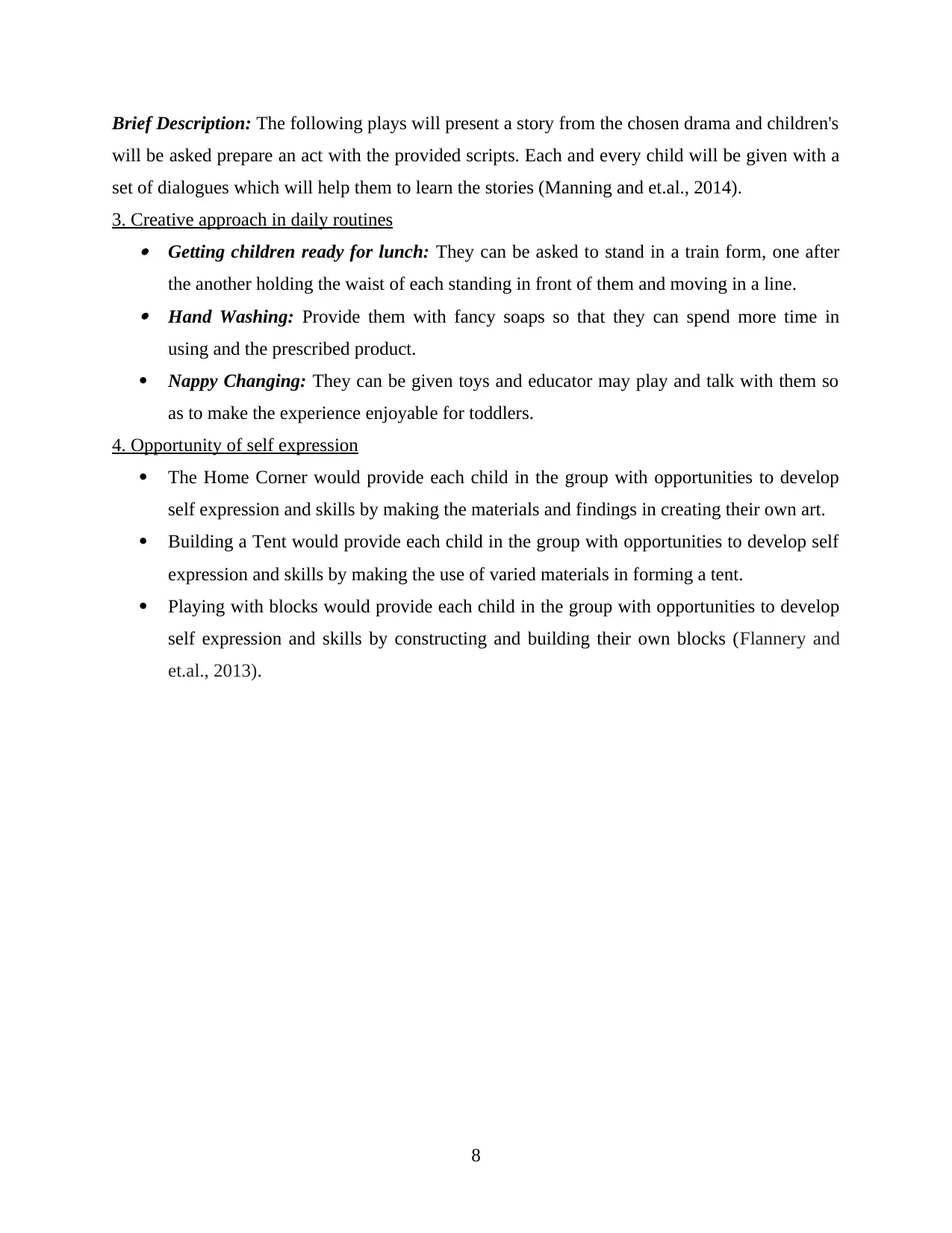
Brief Description: The following plays will present a story from the chosen drama and children's
will be asked prepare an act with the provided scripts. Each and every child will be given with a
set of dialogues which will help them to learn the stories (Manning and et.al., 2014).
3. Creative approach in daily routines Getting children ready for lunch: They can be asked to stand in a train form, one after
the another holding the waist of each standing in front of them and moving in a line. Hand Washing: Provide them with fancy soaps so that they can spend more time in
using and the prescribed product.
Nappy Changing: They can be given toys and educator may play and talk with them so
as to make the experience enjoyable for toddlers.
4. Opportunity of self expression
The Home Corner would provide each child in the group with opportunities to develop
self expression and skills by making the materials and findings in creating their own art.
Building a Tent would provide each child in the group with opportunities to develop self
expression and skills by making the use of varied materials in forming a tent.
Playing with blocks would provide each child in the group with opportunities to develop
self expression and skills by constructing and building their own blocks (Flannery and
et.al., 2013).
8
will be asked prepare an act with the provided scripts. Each and every child will be given with a
set of dialogues which will help them to learn the stories (Manning and et.al., 2014).
3. Creative approach in daily routines Getting children ready for lunch: They can be asked to stand in a train form, one after
the another holding the waist of each standing in front of them and moving in a line. Hand Washing: Provide them with fancy soaps so that they can spend more time in
using and the prescribed product.
Nappy Changing: They can be given toys and educator may play and talk with them so
as to make the experience enjoyable for toddlers.
4. Opportunity of self expression
The Home Corner would provide each child in the group with opportunities to develop
self expression and skills by making the materials and findings in creating their own art.
Building a Tent would provide each child in the group with opportunities to develop self
expression and skills by making the use of varied materials in forming a tent.
Playing with blocks would provide each child in the group with opportunities to develop
self expression and skills by constructing and building their own blocks (Flannery and
et.al., 2013).
8
Paraphrase This Document
Need a fresh take? Get an instant paraphrase of this document with our AI Paraphraser
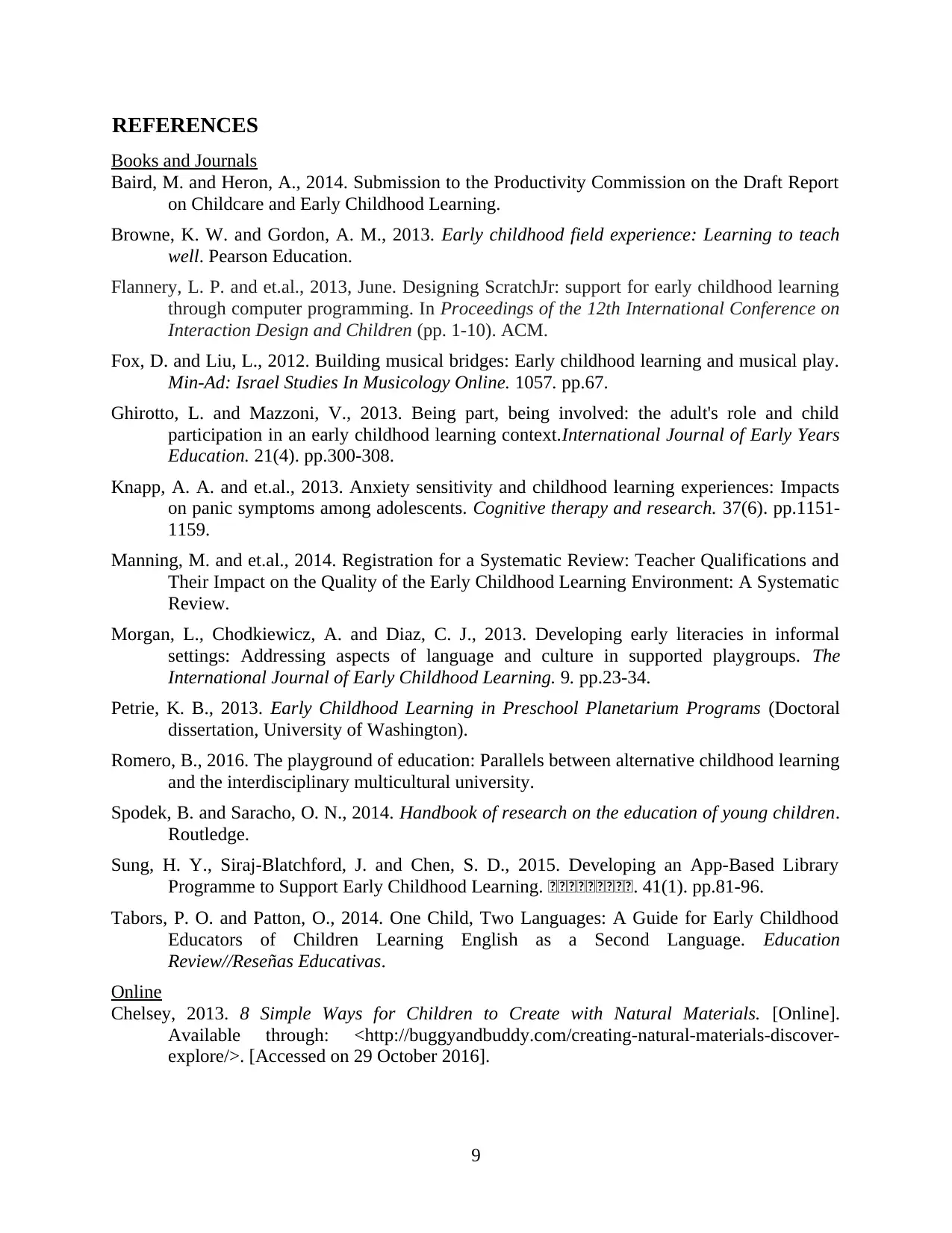
REFERENCES
Books and Journals
Baird, M. and Heron, A., 2014. Submission to the Productivity Commission on the Draft Report
on Childcare and Early Childhood Learning.
Browne, K. W. and Gordon, A. M., 2013. Early childhood field experience: Learning to teach
well. Pearson Education.
Flannery, L. P. and et.al., 2013, June. Designing ScratchJr: support for early childhood learning
through computer programming. In Proceedings of the 12th International Conference on
Interaction Design and Children (pp. 1-10). ACM.
Fox, D. and Liu, L., 2012. Building musical bridges: Early childhood learning and musical play.
Min-Ad: Israel Studies In Musicology Online. 1057. pp.67.
Ghirotto, L. and Mazzoni, V., 2013. Being part, being involved: the adult's role and child
participation in an early childhood learning context.International Journal of Early Years
Education. 21(4). pp.300-308.
Knapp, A. A. and et.al., 2013. Anxiety sensitivity and childhood learning experiences: Impacts
on panic symptoms among adolescents. Cognitive therapy and research. 37(6). pp.1151-
1159.
Manning, M. and et.al., 2014. Registration for a Systematic Review: Teacher Qualifications and
Their Impact on the Quality of the Early Childhood Learning Environment: A Systematic
Review.
Morgan, L., Chodkiewicz, A. and Diaz, C. J., 2013. Developing early literacies in informal
settings: Addressing aspects of language and culture in supported playgroups. The
International Journal of Early Childhood Learning. 9. pp.23-34.
Petrie, K. B., 2013. Early Childhood Learning in Preschool Planetarium Programs (Doctoral
dissertation, University of Washington).
Romero, B., 2016. The playground of education: Parallels between alternative childhood learning
and the interdisciplinary multicultural university.
Spodek, B. and Saracho, O. N., 2014. Handbook of research on the education of young children.
Routledge.
Sung, H. Y., Siraj-Blatchford, J. and Chen, S. D., 2015. Developing an App-Based Library
Programme to Support Early Childhood Learning. 圖圖圖圖圖圖圖圖圖. 41(1). pp.81-96.
Tabors, P. O. and Patton, O., 2014. One Child, Two Languages: A Guide for Early Childhood
Educators of Children Learning English as a Second Language. Education
Review//Reseñas Educativas.
Online
Chelsey, 2013. 8 Simple Ways for Children to Create with Natural Materials. [Online].
Available through: <http://buggyandbuddy.com/creating-natural-materials-discover-
explore/>. [Accessed on 29 October 2016].
9
Books and Journals
Baird, M. and Heron, A., 2014. Submission to the Productivity Commission on the Draft Report
on Childcare and Early Childhood Learning.
Browne, K. W. and Gordon, A. M., 2013. Early childhood field experience: Learning to teach
well. Pearson Education.
Flannery, L. P. and et.al., 2013, June. Designing ScratchJr: support for early childhood learning
through computer programming. In Proceedings of the 12th International Conference on
Interaction Design and Children (pp. 1-10). ACM.
Fox, D. and Liu, L., 2012. Building musical bridges: Early childhood learning and musical play.
Min-Ad: Israel Studies In Musicology Online. 1057. pp.67.
Ghirotto, L. and Mazzoni, V., 2013. Being part, being involved: the adult's role and child
participation in an early childhood learning context.International Journal of Early Years
Education. 21(4). pp.300-308.
Knapp, A. A. and et.al., 2013. Anxiety sensitivity and childhood learning experiences: Impacts
on panic symptoms among adolescents. Cognitive therapy and research. 37(6). pp.1151-
1159.
Manning, M. and et.al., 2014. Registration for a Systematic Review: Teacher Qualifications and
Their Impact on the Quality of the Early Childhood Learning Environment: A Systematic
Review.
Morgan, L., Chodkiewicz, A. and Diaz, C. J., 2013. Developing early literacies in informal
settings: Addressing aspects of language and culture in supported playgroups. The
International Journal of Early Childhood Learning. 9. pp.23-34.
Petrie, K. B., 2013. Early Childhood Learning in Preschool Planetarium Programs (Doctoral
dissertation, University of Washington).
Romero, B., 2016. The playground of education: Parallels between alternative childhood learning
and the interdisciplinary multicultural university.
Spodek, B. and Saracho, O. N., 2014. Handbook of research on the education of young children.
Routledge.
Sung, H. Y., Siraj-Blatchford, J. and Chen, S. D., 2015. Developing an App-Based Library
Programme to Support Early Childhood Learning. 圖圖圖圖圖圖圖圖圖. 41(1). pp.81-96.
Tabors, P. O. and Patton, O., 2014. One Child, Two Languages: A Guide for Early Childhood
Educators of Children Learning English as a Second Language. Education
Review//Reseñas Educativas.
Online
Chelsey, 2013. 8 Simple Ways for Children to Create with Natural Materials. [Online].
Available through: <http://buggyandbuddy.com/creating-natural-materials-discover-
explore/>. [Accessed on 29 October 2016].
9

Puppets: Make them and use them. 2011. [PDF]. Available through:
<http://www.childcarequarterly.com/pdf/fall11_puppets.pdf>. [Accessed on 29 October
2016].
10
<http://www.childcarequarterly.com/pdf/fall11_puppets.pdf>. [Accessed on 29 October
2016].
10
⊘ This is a preview!⊘
Do you want full access?
Subscribe today to unlock all pages.

Trusted by 1+ million students worldwide
1 out of 12
Related Documents
Your All-in-One AI-Powered Toolkit for Academic Success.
+13062052269
info@desklib.com
Available 24*7 on WhatsApp / Email
![[object Object]](/_next/static/media/star-bottom.7253800d.svg)
Unlock your academic potential
Copyright © 2020–2025 A2Z Services. All Rights Reserved. Developed and managed by ZUCOL.





